Fairy Tales & Fables Part 1: Little Red Riding Hood, The Three Billy Goats Gruff, & The Three Little Pigs
There are so many reasons for parents to read fairy tales and fables to young
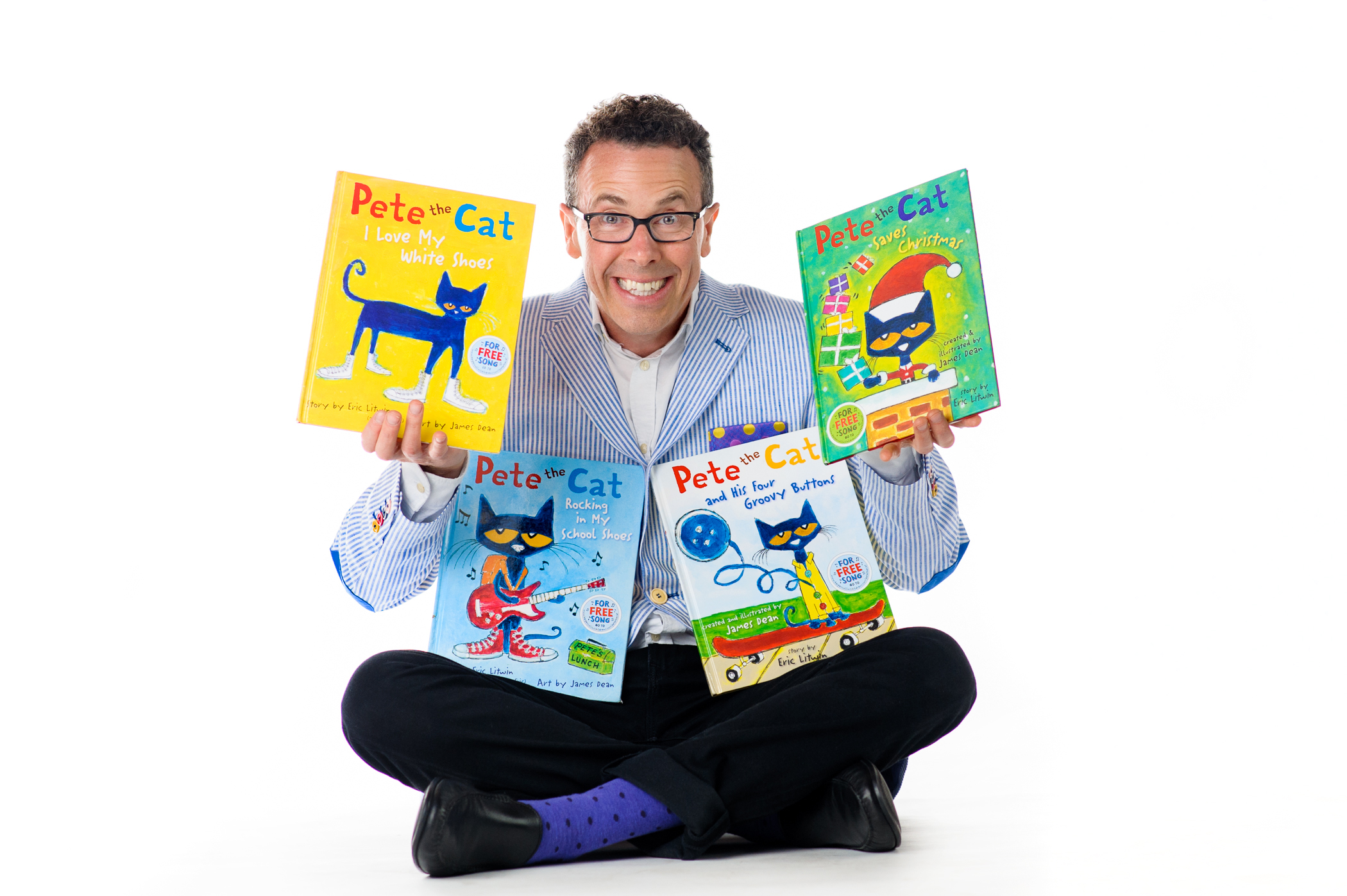
If you aren't living under a rock, you are familiar with Eric Litwin. He is the # 1 New York Times best-selling author of the original four Pete the Cat books (Pete the Cat: I Love My White Shoes, Pete the Cat: Rocking in My School Shoes, Pete the Cat and His Four Groovy Buttons, and Pete the Cat Saves Christmas) and The Nuts series (The Nuts: Bedtime at the Nuthouse and The Nuts: Sing and Dance in Your Polka-Dot Pants).
His latest, Groovy Joe: Ice Cream and Dinosaurs, illustrated by the talented Tom Lichtenheld, is the first in a new series published by Scholastic, and is my sons' current bedtime obsession. It has a positive message, ice cream, and dinosaurs—and deserves to be wrapped up for every kid this holiday season.
I wrote to Eric Litwin soon after I launched this blog. At the time, I struggled to connect with my son Luke, but after his twin Harry's ABA therapist Daisy brought over a copy of Pete the Cat and His Four Groovy Buttons, things slowly changed. Before I knew it, reading Groovy Buttons, White Shoes, and School Shoes was something I could do with Luke that he delighted in. It was also one of the only ways I heard his beautiful, tiny voice. Luke loved the call and response of answering "Did Pete cry?" with "Goodness no!"
In my email, I told Eric how much his books meant to my family and I mentioned my nascent blog. He emailed me back a few days later, thrilled to hear from a special needs mom. His career in special education, I learned, was a huge part of why he became an author, and he was very excited to talk to me and my readers. I am thrilled to be able to share this thought-provoking conversation we had a few weeks ago.
MAMA BIBLIOSOPH: I've been interested in you as an author for a long time. I am always trying to figure out why some books, like yours, work better than others for kids on the spectrum. How did you come to be a children's author?
ERIC LITWIN: So my original career path was to become a teacher, and then a principal, and then run for political office. I’m kind of a Type A personality. I have two Masters degrees; one is in Education and the other is in Administration.
But what happened was that as a teacher, and this was in a special needs classroom, I came to the realization that the students had a lot of problems, and that I couldn’t solve all their problems, but that maybe—hopefully—what I could do was help them fall in love with reading and books. I knew that any solution that worked for them was going to need a strong foundation in literacy. And I became really interested in how to do this.
I also had this one critical experience. I was walking past a kindergarten classroom and I heard the teacher ask, “Who wants to read?” and every child wanted to read; they were so excited! Then I went to my third grade classroom and asked the same question, “Who wants to read?” and some were excited, many were neutral, and many did not want to read. And the basic question I asked myself was: What happened between kindergarten and third grade that so many students no longer loved books?
That was the question that bothered me. Now, all children learn differently, we know this, and yet when we approach early reading we only utilize visual techniques: teaching sight words (so words you recognize) and phonics. And I began to wonder, why don’t we use more techniques? Why don’t we add more into the books to make them work better?
So I started adding music, movement, and call-and-response, and repetition, rhyme, and rhythm schemes. At the time there were no words for this—it was 20 years ago when I started doing this—but now this is often called "multi-sensory learning."
I think multi-sensory is a good word, but the problem is that it leaves out another thing that’s important, which is multi-cognitive learning. My basic feeling is that eventually we need to learn to read with sight words and phonics, but that doesn’t happen until 3rd or 4th grade. So there are four or more years when I think it is essential to have books that have as many ways as possible that a child can read successfully. And then we can use the combination of techniques that work for that child. And it becomes a self-selective approach.
Perhaps the environment at home is too focused on visual stimulation and the child needs verbal stimulation. Whatever the case, they read successfully, they have a positive experience, they feel the joy of literacy, and they want to read more. And here is the key: The single most important thing to improve a child’s reading skills and reading comprehension, is to for them to read.
I know that sounds like a catch 22, but what it means is that you need as much time with their faces in books as possible. And then what happens is that they get practice. And it is so superior to drilling with vocabulary cards and such; that’s just not as effective. Reading all the time is.
When you were talking about what some people call multi-sensory learning, one of the things that you didn’t mention, but that I know you do, or maybe your publisher does, is making music videos for your books. Now, is that controversial? My kids like watching the videos. They like learning the books that way. They learn the tune to the song and then when we read the book later they are really interested because they know it from the video. Obviously you are choosing to do this for a reason. Can you tell me how you feel about it?
Well, I think a multi-faceted approach to a book is ideal. It’s not just videos. I also do live shows. There are also dances that kids can do with my new books. My assistant was telling me today that she met a child who doesn’t like to read my books, she likes to act my books.
Now, I think we can all agree that unlimited screen time is not a good thing. And how long that should be depends on the child. However, some screen time, especially when used to promote literacy, is positive. But when someone says, “This approach is wrong,” what you have is an adult prescribing how a child should learn. What I’m saying is let’s give them every technique possible and watch and listen. When we try to create programs that say all children learn the same way it doesn’t work. It works for some kids, but leaves out many others.
I’m trying to create books that have many, many ways a kid can succeed. So what does a kid respond to? Maybe the combination of the video combined with the tactile of holding the book. Maybe it’s the music. Maybe it’s rhyme. And another child picks up the book and likes that they can detect a structure and pattern. And then there’s the very physical and active child, like the one I described, who wants to act it out. All these pathways should be open so that the child feels smart, and feels joy, and feels pleasure. And if we only give kids books with a few ways—primarily visual—to succeed, and that’s not their strength, what’s going to happen?
So when you sat down to write your first book, Pete the Cat: I Love My White Shoes, did you have this mental list already? Did you think, okay, it needs repetition, and music, and rhyme, and to have call-and-response opportunities? How did you tackle that?
I first tackled it as a classroom teacher trying to make literacy accessible. I am a storyteller, and I’m also a musician. So I started to bring in music. And I added movement. And I did that to get them engaged. But the response was beyond what I anticipated.
And that’s when the creative light bulb went off. Today, if that were happen to a young teacher, they would have the vocabulary to understand it—multi-sensory. So what happened is that I became aware that this was my calling and I started working on the development of this literary approach. And I started giving concerts and became fairly successful and popular as an educational entertainer doing mostly school assemblies. I spent 10 years developing all these techniques.
Did I have a list of things that had to be in a story? Yeah, I did. It wasn’t a solid concept though, not at first.
Were there other authors or picture books that inspired you?
Oh yes, Bill Martin, Jr. He was certainly one of my heroes, there were just some things I wanted in addition. I love Brown Bear, Brown Bear. It’s simple, it’s got repetition, a circular pattern; it’s delightful. But for my own books I wanted a story arc with conflict resolution, I wanted a song, and I wanted movement. But certainly Bill Martin, Jr. was the beginning. He made what I do possible.
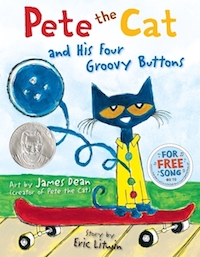
So let’s talk more about your books. Both Pete the Cat: I Love My White Shoes and Pete the Cat and His Four Groovy Buttons have to do with a personal possession getting ruined or broken and how to stay cool in that situation. For me, as a parent of children with autism, these books are all about coping skills and self-regulation. Why this particular topic?
Well, they say that every story is a love story. Something happens to the love object and the protagonist—the hero—has to deal with it.
There were a number of things I wanted to accomplish. One: The educational pedagogy we were talking about. That remains a very high priority for me. However, I’m also deeply concerned about the pessimism and negativity floating around our society. And I would say things have only gotten worse—and things were bad when I started.
I wanted to create books that used simple metaphors, simple conflict resolution to promote a positive attitude. And I think that’s because staying positive is something we work at. It’s like being in good physical shape. I think it’s the same thing with attitude. Without good ideas and exercise (and I consider the contemplation of positive ideas to be the exercise) you can’t stay positive.
So that’s what I was thinking about. And I love the old fables and Aesop’s Tales and Zen-Buddhist stories. But I wanted a modern metaphor. You have a pair of shoes and you step in something. You have buttons and they pop off and roll away.
And with lines like “I love my white shoes,” I wanted people to sing the word "love." You know? So you start to surround your mind with positive words.
Pete the Cat: Rocking in My School Shoes is your school anxiety story, and you chose to structure the book as an exploration of the parts of a school building. I got to say, this is just brilliant for a kid on the spectrum—
Every child, really.
I'm sure! But kids with autism can be unusually overwhelmed by new spaces, particularly large and chaotic ones. How did you develop this new approach to the school anxiety subgenre?
Well, it’s just because I was a special needs teacher. So after book one, the editor asked for a book about school. Most books about school focus on conflicts like you can’t find anyone to sit with in the lunchroom or this kid is mean or you aren’t making friends right away.
But what I knew is that unstructured time and overstimulation are the greatest sources of anxiety.
Also the new and unfamiliar.
Right. You go to the library and you’ve never been there before.
So I wanted to create a book about unstructured, overstimulating environments. And not everyone realizes that this is what stresses out so many kids. People think kids like the chaos since they are creating it. And some do. But many, many do not.
And boy did that take off. That was the first time I had a New York Times bestseller.
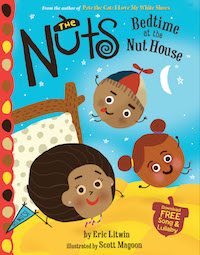
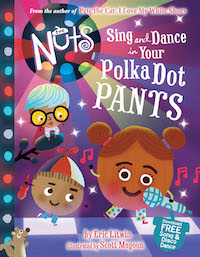
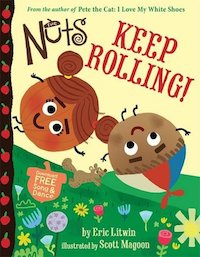
Tell me about what you are doing differently with The Nuts.
So the next book in that series, The Nut Family: Keep Rolling! isn't out yet. That one returns to the positivity message, which is my personal favorite subgenre.
The first two are basically about a family that sticks together. Things are nutty, but if there's a conflict, it’s okay.
So the first book, Bedtime at the Nut House is about bedtime conflicts. And the second book, Sing and Dance in Your Polka Dot Pants, is the conflict that occurs when a child wants more attention but the adult needs to do adult things or is exhausted. So just like Rocking in My School Shoes, which addresses what’s really going on at school, The Nuts address what’s really going on at home: 'I don’t want to go to bed' or 'I want attention.'
And the illustrator of those books is Scott Magoon. He’s a terrific artist. Book three is wonderfully bright. I think your readers will really love this book. Here’s a taste:
Hazel and Wally were really small.
They wanted to be big and tall.
So they rolled through sticky mud and goo.
The more they rolled, the bigger they grew.
And they sang this song: Keep rolling! Keep rolling!
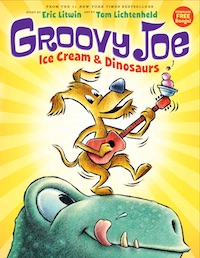
Groovy Joe: Ice Cream and Dinosaurs is obviously another one of your positive thinking books with the refrain "It's awesome to share!"
I wanted to ask you about sharing. This is a really hard social skill for kids on the spectrum. So I love having picture books that find ways to model it.
However, in the parenting community right now there is a lot of pushback about teaching sharing. There is a constant onslaught of clickbait on parenting sites saying we shouldn’t force kids to share because it’s unnatural or developmentally inappropriate. There are even preschools that insist children shouldn't be forced to share toys. My kids briefly attended one. They make arguments such as, "In the real world, adults don't share their property, like their phones, so why should kids have to share their toys?" Have you had to deal with this attitude about sharing with Groovy Joe?
No, I haven’t. And the idea that there is any harm in teaching children to share is really misguided. We all have to share. We pay taxes, we share the highway—and you do have to share your phone with people! You can’t necessarily talk as loud as you want wherever you are, for instance. We all live in a social environment. And learning to share is a big part of what it means to grow up.
We need not to be Pollyanna about it, either. I mean, in Groovy Joe, Joe doesn’t want to share his ice cream.
No! And dinosaurs have broken into his house!
With spoons! And he basically has to decide if he should fight them or make a run for it. So his offering to share is kind of clever because he actually gets to still have some of his ice cream. And in the end, when the ice cream is gone, those dinosaurs are looking at him like maybe they are going to eat him now. And he still manages to turn it around.
So when he says, “It’s awesome to share!” I see that as Joe selling that idea to the dinosaurs.
I generally don’t try to approach these things in a way that is too rosy. I mean in Pete the Cat: I Love My White Shoes, sure, his shoes are white again at the end, but now they are wet, right? And in Groovy Buttons he never gets those buttons back.
And so with Joe and his ice cream, he shares, he gets less because of it, but he finds a way to have fun and make friends and not get eaten. And that’s what life is about—making friends and not getting eaten.
Final question. I wanted to ask for tips about how to read to children with autism. In the FAQ section of my blog, "Put on a Broadway show" is one piece of advice I give. Be animated. Expressive. Move your body. Give kids space to be physically interactive and model that. Praise participation. Etcetera.
I have the basics, I think. But I’ve watched videos of your live shows from your YouTube channel, and you take it a different level.
It’s all in my books. For example, in Groovy Joe, you have that repeating scene:
Roar!
OH NO!
A big dinosaur bursts into the room.
He stares at the ice cream and pulls out a...
And then what do you have to do? The word “spoon” isn’t on that page. So you have to turn the page, but a kid is probably going to yell out “spoon” before you get there. This was actually the illustrator Tom Lichtenheld's idea, and it works wonderfully.
So you have adult-proofed your books.
Ha! Yes. And the rhyme scheme should be impenetrable. It lines up. So in The Nuts, you get lines like:
Hazel likes to sing and dance.
Hazel loves her polka dot pants.
It’s designed to help you whether you are musical or not.
So what makes a book engaged learning and interactive? One thing is repetition. Kids figure out what’s going to happen and they say it before you can. Another is rhyme. That creates prediction too. When you combine rhyme and repetition even better. Add some rhythm? Even better. Add some music? Even better.
I put all of these things in my books. I try to make it easy for parents. Now there are some things I can’t include in my books. I would love parents to add movement. You can add a hand motion to a repetitive phrase. You can add movement to rhythm. I would highly encourage all of this.
Groovy Joe saw something yummy
Groovy Joe started rubbing his tummy.
So use a hand gesture to rub your tummy. Or use call and response:
Did Pete Cry?
Pause. Let the kids answer, “Goodness no!”
I also think humor is a way that your books promote interactivity. Silliness helps both of my children really engage with books. They like the “POP!” in Groovy Buttons when the buttons pop off Pete's shirt. They think it’s hilarious.
Yeah, I think reading a book should be like slapstick humor. When you “POP!” you should ideally “Pooooooppp!" and really move your body and make that big. Kids will think that’s the funniest thing they’ve ever seen and that you are a brilliant comedian. So you move your body, make facial expressions, and each time you do, you build that story.
These are certain things you witness when you watch a storyteller or a comedian or a clown. And these things are open and available to everybody and parents and teachers should be utilizing these techniques all the time.
There’s one more significant interactive technique that we haven’t talked about which I don’t think my books need because there are other things built-in, but that’s dialoging (dialogic reading). That’s when you read a little bit and then you ask questions. Read a little bit more, and ask questions. So that's another technique.
With the emerging reader, there is so much competition. That iPad is a fierce competitor! So you want to make the reading experience extraordinarily fun and special.